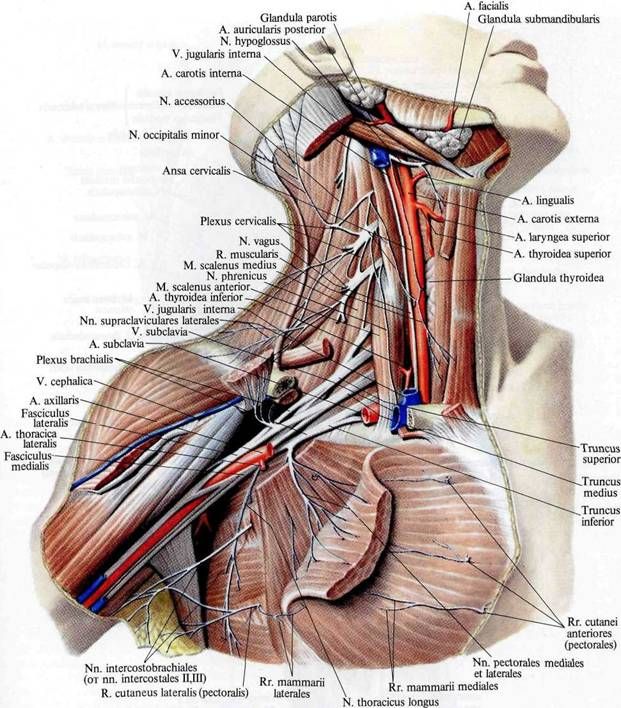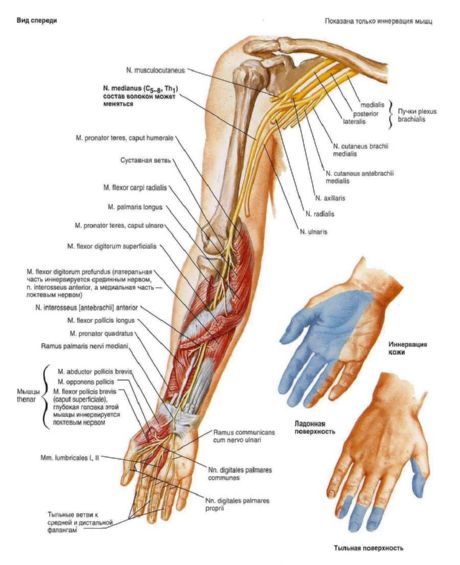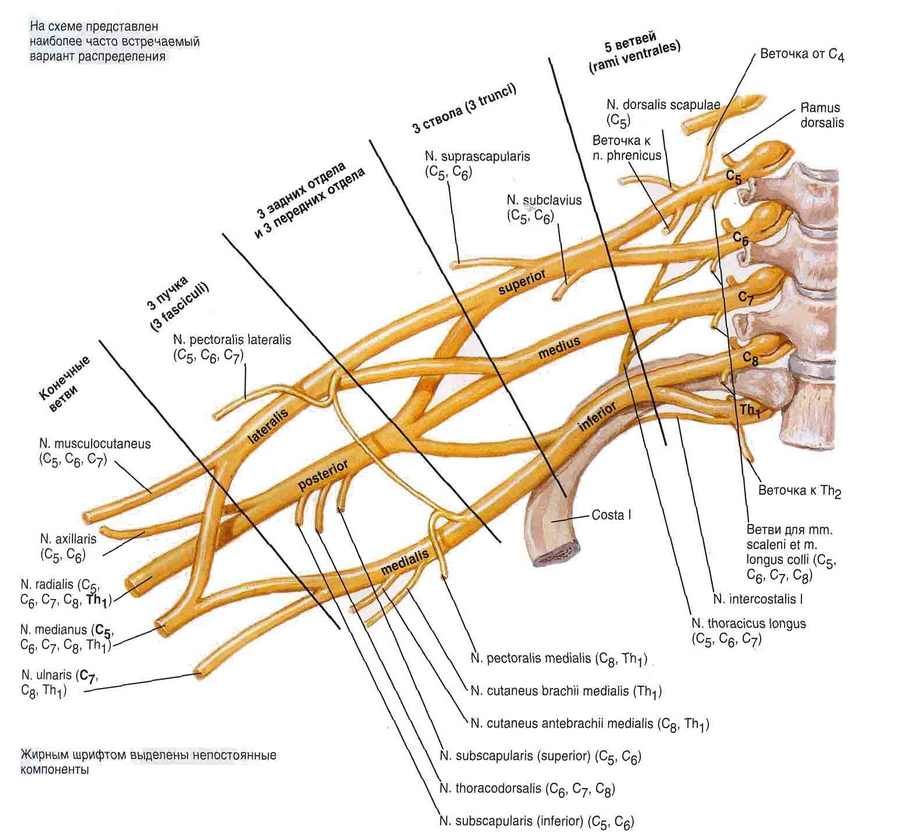Brachial plexus
Last reviewed: 23.04.2024

All iLive content is medically reviewed or fact checked to ensure as much factual accuracy as possible.
We have strict sourcing guidelines and only link to reputable media sites, academic research institutions and, whenever possible, medically peer reviewed studies. Note that the numbers in parentheses ([1], [2], etc.) are clickable links to these studies.
If you feel that any of our content is inaccurate, out-of-date, or otherwise questionable, please select it and press Ctrl + Enter.
The brachial plexus (plexus brachialis) is formed by the anterior branches of the four lower cervical (CV-СVIII) spinal nerves. In the structure of the plexus, the supraclavicular and subclavian parts (pars supraclavicularis et pars infraclavicularis) are distinguished according to the topographic feature. Initially, the brachial plexus is located in the interstitial space (supraclavicular part), where the upper, middle and lower trunks of the brachial plexus are distinguished . From the interstitial space, these trunks extend into a large supraclavicular fossa (scapula-trapezoidal triangle). At the level of the clavicle and below, the trunks of the brachial plexus form three bundles (subclavian part) surrounding the armpit axillary artery. In relation to the axillary artery is the medial, lateral and posterior fascicles (fasciculi medialis, lateralis, posterior) of the brachial plexus. To the brachial plexus fit the connecting branches from the middle cervical node of the sympathetic trunk of its side. Short and long branches leave the brachial plexus. Short branches are mainly from the supraclavicular part of the brachial plexus. They innervate the bones and soft tissues of the shoulder girdle. Long branches of the brachial plexus depart from the subclavian part of the brachial plexus and innervate the free part of the upper limb.


Short branches of the brachial plexus
The short branches of the brachial plexus include the dorsal (posterior) nerve of the scapula, the long thoracic, subclavian, supralpate, subscapular, thoracic, lateral and medial thoracic nerves, as well as the axillary nerves. Muscular branches also belong to the short branches of the brachial plexus, they innervate the stair muscles and the waist muscle of the neck.
- The dorsal nerve of the scapula (n. Dorsalis scapulae) departs from the anterior branches of the fourth and fifth cervical spinal nerves. The nerve passes along the front surface of the muscle that lifts the scapula, then between the middle and back stair muscles and branches into the large and small diamond-shaped muscles and the muscle that lifts the scapula.
- The long thoracic nerve (n. Thoracicus longus) originates from the anterior branches of the fifth and sixth spinal nerves (CV-CVI), behind the brachial plexus. Next, the nerve is located between the subscapular and anterior jagged muscles, going downward between the lateral thoracic arteries in front and the thoracic artery from behind. Innervates the anterior dentate muscle.
- The subclavian nerve (n. Subclavius) is formed by the anterior branch of the fifth spinal nerve. The nerve runs the shortest way along the outer edge of the anterior staircase to the subclavian muscle. Often the subclavian nerve gives the branch to the diaphragmatic nerve.
- The suprascapular nerve (n. Suprascapularis) is formed by the anterior branches of the fifth and sixth spinal nerves. It is separated directly from the upper bundle of the brachial plexus. Initially, the nerve passes near the upper edge of the brachial plexus under the trapezius muscle and the lower abdomen of the scapular-hyoid muscle. Further behind the collarbone, the nerve forms a bend in the lateral side and posteriorly, passes into the supine fossa through the scapula of the scapula under the upper transverse ligament. Then, along with the transverse artery of the scapula, the suprathiopathic nerve passes under the base of the acromion into the subacute fossa. Innervates the supine and subacute muscles, the capsule of the shoulder joint.
- The subscapular nerve (n. Subscapularis) departs from the anterior branches of the fifth-seventh spinal nerves with two or three stems, runs along the anterior surface of the subscapular muscle. It innervates the subscapular and large round muscles.
- The thoracic nerve (n. Thoracodorsalis) is formed from the anterior branches of the fifth-seventh spinal nerves, directed down along the outer edge of the scapula to the widest back muscle that innervates.
- The lateral and medial thoracic nerves (nn. Pectorales lateralis and medialis) originate from the lateral and medial bundles of the brachial plexus (CV-ThI). The nerves go forward, perforate the clavicle-thoracic fascia and end in the large thoracic (medial nerve) and in the small thoracic (lateral nerve) muscles.
- The axillary nerve (n. Axillaris) starts from the posterior fascicle of the brachial plexus (CV-CVIII). The nerve goes laterally and down the front surface of the subscapular muscle, then turns back. Together with the posterior artery circumscribing the humerus, the nerve passes through the four-sided opening and emerges on the back surface of the shoulder. Next, the nerve enters the deltoid muscle from the lateral surface of the surgical neck of the humerus, giving a small branch to the small round muscle and the capsule of the shoulder joint. The final branch of the axillary nerve is the upper lateral cutaneous nerve of the shoulder (n. Cutaneus brachii lateralis superior) that extends under the skin between the posterior edge of the deltoid muscle and the long head of the triceps brachii muscle and innervates the skin above the deltoid muscle and in the lateral part of the arm.


Long branches of the brachial plexus
Long branches of the brachial plexus depart from the lateral, medial and posterior fascicles of the subclavian part of the brachial plexus. Among the long branches are the muscular-dermal, median, ulnar nerves, the medial cutaneous nerve of the shoulder, the medial cutaneous nerve of the forearm and the radial nerve.
- The musculocutaneous nerve (n. Musculocutaneus) departs from the lateral bundle of the brachial plexus. This nerve is formed by the anterior branches of the fifth-eighth (CV-CVIII) cervical spinal nerves. The musculocutaneous nerve goes down and laterally, perforates the beak-brachial muscle and gives it branches. Initially, the nerve is located lateral to the median nerve, then it is separated from the nerve. On the shoulder, the musculocutaneous nerve passes between the brachial and biceps muscles of the shoulder, and gives to them the muscular branches (rr. Musculares). At the level of the elbow joint, lateral to the terminal section of the biceps tendon of the shoulder, the musculocutaneous nerve perforates the fascia of the shoulder and continues into the lateral cutaneous nerve of the forearm (n. Cutaneus anteabrachii lateralis), which descends under the skin along the lateral side of the forearm. The lateral cutaneous nerve of the forearm innervates the skin of this area up to the elevation of the thumb.
- The median nerve (n. Medianus) departs from the fusion of lateral and medial bundles of the brachial plexus of the fibers of the anterior branches of the sixth to eighth cervical and first thoracic (CVI-ThI) spinal nerves. Both bundles are connected at an acute angle in front of the axillary artery. On the shoulder, the median nerve passes first in one fascial case with the brachial artery, lateral to it. The projection of the median nerve corresponds to the location of the medial groove of the shoulder.
- The ulnar nerve (n. Ulnaris) departs from the medial bundle of the brachial plexus. It consists of the fibers of the anterior branches of the eighth cervical - the first thoracic (СVIII-ThI) spinal nerves. Initially, the ulnar nerve is located next to the median nerve and slightly medial to the brachial artery. In the middle third of the shoulder, the nerve deviates into the medial side, then perforates the medial intermuscular septum of the shoulder and goes down to the posterior surface of the medial epicondyle of the humerus.
- The medial cutaneous nerve of the shoulder (n. Cutaneus brachii medialis) is formed by fibers of the anterior branches of the eighth cervical and first thoracic spinal nerves (CVIII-Th1), departs from the medial bundle of the brachial plexus and accompanies the brachial artery. At the base of the axillary cavity, the medial cutaneous nerve of the shoulder connects with the lateral cutaneous branches of the second and third intercostal nerves and is called the intercostal-brachial nerve (n., Intercostobrachialis). Next, the medial cutaneous nerve of the arm penetrates the axillary and brachial fascia and branches into the skin of the medial side of the shoulder to the medial epicondyle of the humerus and the ulnar process of the ulna.
- The medial cutaneous nerve of the forearm (n. Cutaneus antebrachii medialis) consists of the fibers of the anterior branches of the eighth cervical - the first thoracic (CVII-Th) of the spinal nerves. It leaves the medial bundle of the brachial plexus and is attached to the brachial artery. Initially, the nerve is located deep on the shoulder, then perforates the fascia of the shoulder at the point where the medial saphenous vein enters the arm in one of the shoulder veins. The branches of the medial cutaneous nerve of the forearm innervate the skin of the medial side of the lower part of the shoulder and the back of the non-medial side of the forearm.
- Radial nerve (n. Radialis) is an extension of the posterior fasciculus of the brachial plexus. It consists of the fibers of the anterior branches of the fifth cervical - the first thoracic (CV-ThI) spinal nerves.

